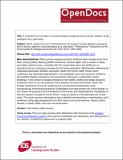| dc.contributor.author | Cunningham, Andrew A. | |
| dc.contributor.author | Field, Hume E. | |
| dc.contributor.author | Epstein, Jonathan H. | |
| dc.contributor.author | Breiman, Robert F. | |
| dc.contributor.author | Suu-Ire, Richard | |
| dc.contributor.author | Ntiamoa-Baidu, Yaa | |
| dc.contributor.author | Fahr, Jakob | |
| dc.contributor.author | Kamin, Alexandra O. | |
| dc.contributor.author | Peel, Alison J. | |
| dc.contributor.author | Baker, Kate S. | |
| dc.contributor.author | Hayman, David T. S. | |
| dc.contributor.author | Dechmann, Dina | |
| dc.contributor.author | Restif, Olivier | |
| dc.contributor.author | Jones, Kate E. | |
| dc.contributor.author | Fooks, Anthony R. | |
| dc.contributor.author | MacGregor, Hayley | |
| dc.contributor.author | Waldman, Linda | |
| dc.contributor.author | Leach, Melissa | |
| dc.contributor.author | Wood, James L. N. | |
| dc.date.accessioned | 2014-05-02T17:15:55Z | |
| dc.date.available | 2014-05-02T17:15:55Z | |
| dc.date.issued | 2012-09-10 | |
| dc.identifier.citation | Wood, James LN, et al. "A framework for the study of zoonotic disease emergence and its drivers: spillover of bat pathogens as a case study." Philosophical Transactions of the Royal Society B: Biological Sciences 367.1604 (2012): 2881-2892. | en_GB |
| dc.identifier.issn | 0962-8436 | |
| dc.identifier.uri | https://opendocs.ids.ac.uk/opendocs/handle/20.500.12413/3856 | |
| dc.description.abstract | Many serious emerging zoonotic infections have recently arisen from bats, including Ebola, Marburg,SARS-coronavirus, Hendra, Nipah, and a number of rabies and rabies-related viruses, consistent with the overall observation that wildlife are an important source of emerging zoonoses for the human population. Mechanisms underlying the recognized association between ecosystem health and human health remain poorly understood and responding appropriately to the ecological, social and economic conditions that facilitate disease emergence and transmission represents a substantial societal challenge. In the context of disease emergence from wildlife, wildlife and habitat should be conserved, which in turn will preserve vital ecosystem structure and function, which has broader implications for human wellbeing and environmental sustainability, while simultaneously minimizing the spillover of pathogens from wild animals into human beings. In this review, we propose a novel framework for the holistic and interdisciplinary investigation of zoonotic disease emergence and its drivers, using the spillover of bat pathogens as a case study. This study has been developed to gain a detailed interdisciplinary understanding, and it
combines cutting-edge perspectives from both natural and social sciences, linked to policy impacts on public health, land use and conservation. | en_GB |
| dc.description.sponsorship | ESRC. Environmental and Social Ecology of Human Infectious Diseases (ESEI). Ecosystem Services for Poverty Alleviation (ESPA). ANTIGONE. The Alborada Trust. Research and Policy for Infectious Disease Dynamics programme of the Science and Technology Directorate, Department of Homeland Security. Wellcome Trust. David H. Smith postdoctoral fellowship. Royal Society Wolfson Research Merit award. University Research Fellowship from the Royal Society. NIH Fogarty International Center. | en_GB |
| dc.language.iso | en | en_GB |
| dc.publisher | Royal Society Publishing | en_GB |
| dc.rights.uri | http://creativecommons.org/licenses/by/3.0/ | en_GB |
| dc.subject | Health | en_GB |
| dc.title | A framework for the study of zoonotic disease emergence and its drivers: spillover of bat pathogens as a case study | en_GB |
| dc.type | Article | en_GB |
| dc.rights.holder | The Royal Society | en_GB |
| dc.identifier.externaluri | http://rstb.royalsocietypublishing.org/content/367/1604/2881.short | en_GB |


